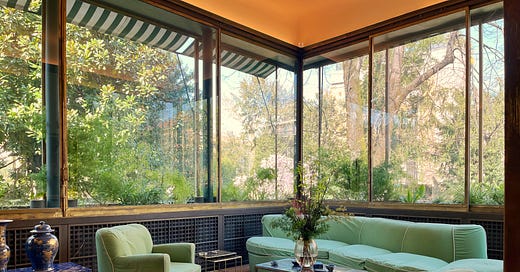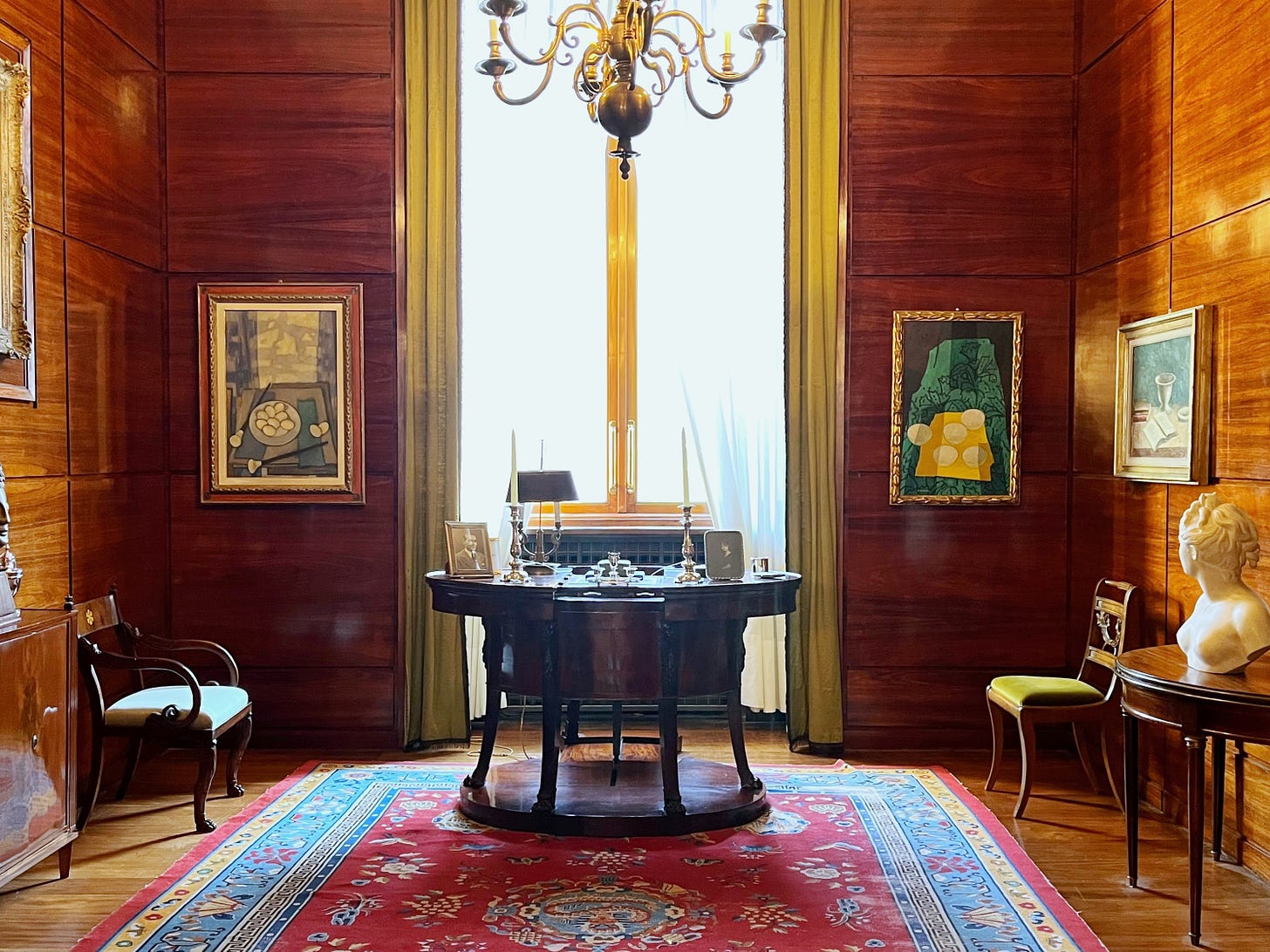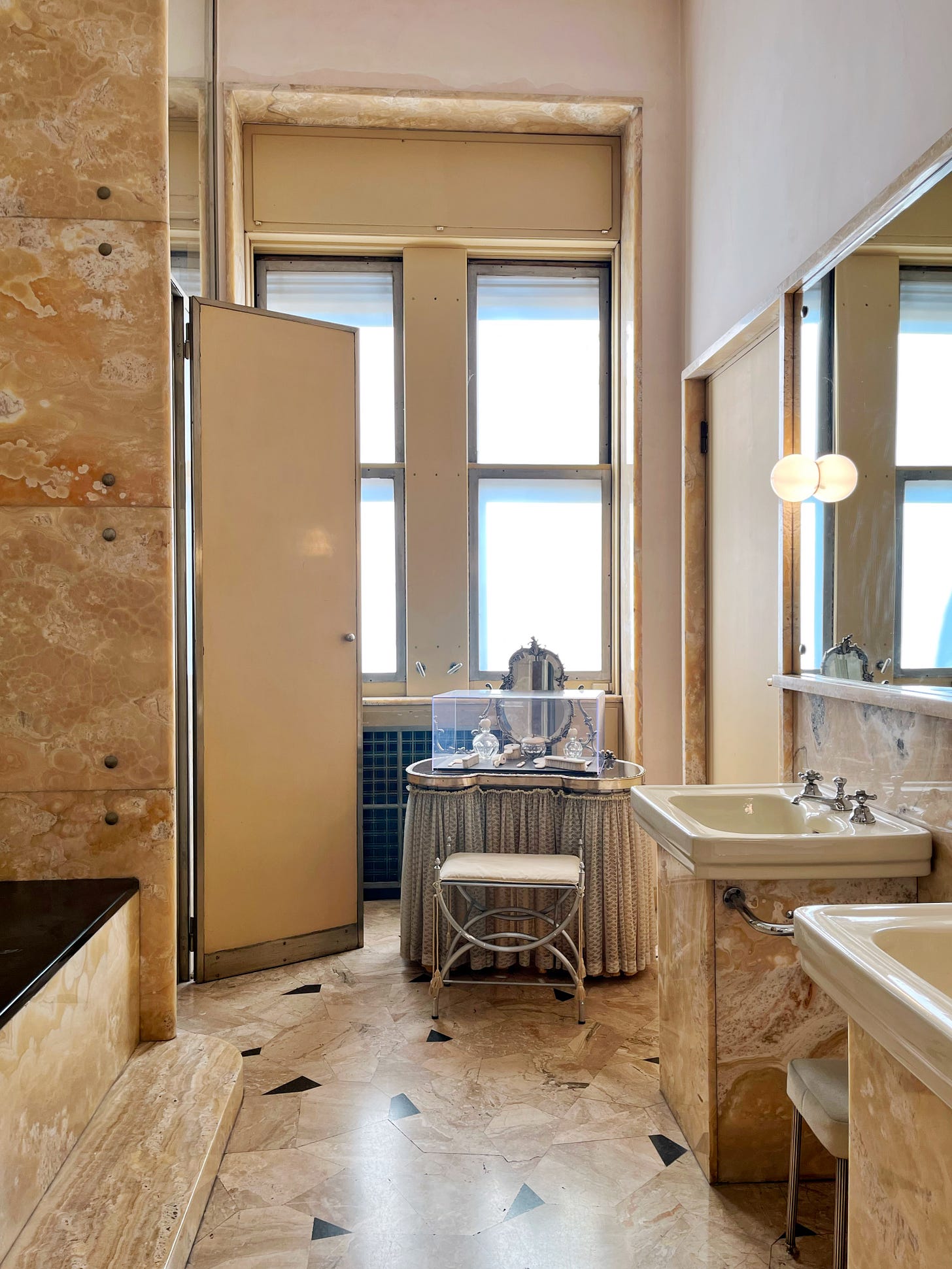On a recent trip to Milan, I had the chance to revisit Villa Necchi Campiglio, which is definitely a must for architecture fans, so today I’m giving you a look inside. If it looks familiar, that might be because it was used as the setting in Luca Guadagnino’s 2009 movie I Am Love starring Tilda Swinton and in Ridley Scott’s 2021 film House of Gucci.
Occupying prime real estate in the center of Milan, with extensive gardens, a large pool, and tennis courts, the home feels more like a countryside villa than a typical urban dwelling. It was built in 1935 by modernist architect Piero Portaluppi, who fully embraced the rationalist and art deco styles of the era.
As our guide explained, the home was commissioned by sisters Nedda and Gigina Necchi, who lived there with Gigina’s husband Angelo Campigli. They were a wealthy industrialist family that aspired to climb the social ranks and mingle with the aristocracy—and they succeeded. Indeed, Queen Margherita of Savoia used to stay at the villa in a suite with an alabaster bathroom.
Though the architecture was very modern at the time, the way the home is organized corresponds to traditional aristocratic homes: the rooms meant for entertaining are on the ground floor, while the bedrooms and bathrooms are on the upper floor. The kitchen was in the basement, so as to avoid noise and odors disturbing the family and their guests. Dumbwaiters were installed to send the food upstairs and intercoms allowed the family to communicate with their staff—quite modern technology for that time.
They filled their home with precious art and antiques, though some of the art (including drawings by Picasso and Modigliani) displayed there now was donated later. In Angelo’s study, though, you can see the Napoleonic campaign desk and in the pantry you can admire their embroidered napkins and a complete set of Ginori porcelain dishes with art deco motifs.
The home’s interiors took on a more 18th-century style when they were redecorated by architect Tommaso Buzzi right after WWII. You can see this very clearly in the dining room, which features a crystal chandelier, antiques, and tapestries.
Personally, my favorite space is the veranda with its enveloping glass windows that look out onto the verdant grounds. If I could, I would put that sinuous mint green sofa in my own home. This space also features beautiful pocket doors with slats that let you peek into the adjacent room.
Upstairs, the sleeping quarters are divided in two: on one side are the suites of Nedda, who never married, and Gigina and her husband Angelo. On the other side, there are a handful of suites for their guests. As our guide pointed out, nowadays this would seem very odd and unfair, but since Nedda remained single, she slept in a twin bed for her entire life. She did, however, have an enviable wardrobe, with beautiful clothes, including Dior scarves with her name written on them and a collection of handbags.
Their bathrooms were very modern for the time, with a large shower, a separate bathtub, pedestal sinks, and porthole windows. Though they all have more or less the same style, they were created using different types of stone or glossy black tiles.
It’s really the details, though, that make the house so special. In the dining room, for instance, the ceiling features celestial and nautical motifs, but it’s done in white-on-white plasterwork, so if you weren’t paying attention you might not even notice it. Meanwhile, diamond-shaped geometric motifs appear on the ceiling in the parlor.
There are family photos and personal objects displayed in some of the rooms, so you can get a sense of who these people were. Nedda was born in 1900 and Gigina was born in 1901. They died in 1993 and 2001, respectively, so their lives spanned pretty much the entire 20th century. I can only imagine the stories they would have told.
Neither sister had children, so when they died, they left the villa and all its contents to FAI, which has maintained it since 2001. I was there as part of the press program of the DUCO Travel Summit, but the villa is open to the public from Wednesday through Sunday. Normal tickets come with an audio guide, but if you can, I recommend doing one of the guided tours so you can ask questions.
Have you been to Villa Necchi Campiglio? If so, what did you think?
Further Reading
You can read more about Villa Necchi Campiglio and book a guided tour here.
Want to know what else to do in Milan? Check out my guide to 72 hours in the city.
I included Villa Necchi Campiglio in this list of the 20 best things to do in Milan for Travel + Leisure.
You can see all of the New Roman Times’ coverage of under-the-radar destinations here.











@Marco and Sabrina, sorry I meant to reply to your comment and accidentally deleted it instead! I'm assuming you were referring to "I Am Love"?
Laura,
We have 3-4 hours to tour Milan! We are thinking of the Duomo, the Mercato Centrale, and one more place. Can you recommend something?